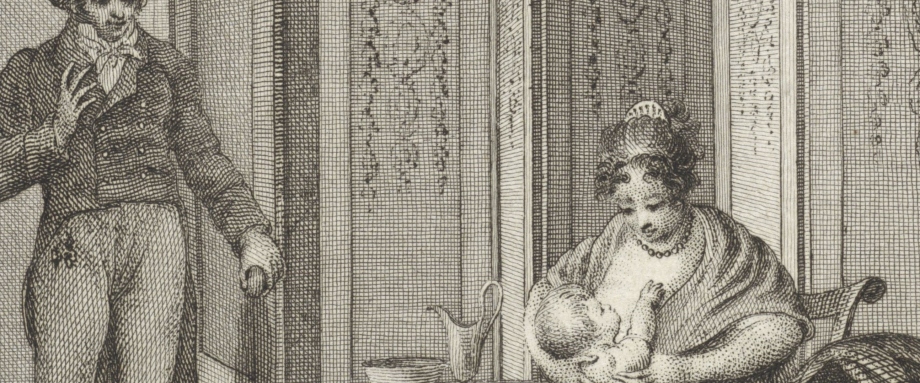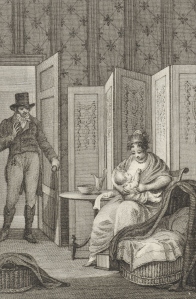PERCEPTIONS OF PREGNANCY
Researchers' Network

The Perceptions of Pregnancy blog, like the Researchers’ Network, aims to reach beyond boundaries and borders, and to facilitate an international and interdisciplinary conversation on pregnancy and its associated bodily and emotional experiences from the medieval to the modern. Today’s post from Leanne Calvert explores men’s roles in childbirth in the nineteenth century.
What about fathers? Men and childbirth: some evidence from nineteenth-century Ulster.
Every week, millions of us tune into Channel 4’s One Born Every Minute –the fly-on-the-wall documentary series that follows midwives and expectant mothers in maternity wards across Britain and Ireland. The unlikely star of the show, however, can be found standing next to the hospital bed –the expectant father. In any given episode, fathers can be seen nervously fidgeting and pacing, holding their partners’ hands, and encouraging them as they puff through each contraction. Many fathers are present at the time of delivery and some even cut the umbilical cord. Such scenes have become commonplace in contemporary society. Today, fathers are a visible presence in the delivery room and, with the increasing availability of paternity leave, are much more involved in early childcare than previous generations of men. But, just how modern is this conception of fatherhood? What role did fathers in past centuries play in childbirth?
It would be easy to assume that fathers played a minimal role in childbirth. Indeed, men are conspicuously absent from histories of pregnancy and childbirth. We are told that these events were largely managed and controlled by women, to the exclusion of men. Childbirth itself even took place in a designated area of the home known as the ‘birthing chamber’ – a space to which men were not permitted entry. The local midwife, close female friends and family of the pregnant woman, and other women experienced in childbirth were usually present at the time of delivery. With the exception of male medical professionals (who were increasingly admitted to the birth chamber as male midwives from the late-eighteenth century onwards), we are told that men played a limited role in childbirth. As fathers, they fetched those who were to attend the birth; they awaited news of the birth with a company of their male friends; or they paid a midwife for her services.[i]

Reinier Vinkeles 1809, Courtesy of the Rijksmuseum
The omission of fathers from the rituals of childbirth can partly be explained by a lack of evidence. Sources that offer an insight into how men felt about, and responded to, childbirth are very rare. Generally, men’s accounts of childbirth offer only brief details such as the time of birth or sex of the infant. For example, when Robert Tennent wrote to his father, the Reverend John Tennent, minister of the Presbyterian congregation of Roseyards, county Antrim, news of the birth of his niece Letitia in 1806, he summed up the event in one line, placed at the end of his letter: ‘Mrs Tennent was safely delivered of a girl the 27th Feb[ruary] & her & it continue pretty well’.[ii] Likewise, the Reverend Robert Magill, minister of 1st Antrim Presbyterian congregation, recorded the birth of his daughter Sarah in 1825 as follows: ‘Mrs Magill gave birth to Sarah at ¼ before 8 oclock this morning’.[iii]
Such clipped descriptions, however, can be misleading. When the Reverend James Morell, minister of Ballybay Presbyterian congregation, county Monaghan, recorded the birth of his son in March 1816, he also used similar language: ‘My Dear Wife presented me with a fine Boy about half past 5 this morning. She was but a short time ill, and is recovering fast’.[iv] The brevity of Morell’s entry, however, masks the true extent of his involvement. He later admitted that the night’s events had not left him ‘time to make much preparation for the [Sabbath] service’ and that he had been forced to ‘preach on an old sermon’.[v] While Morell did not explicitly detail his involvement, it is very likely that he was detained from his ministerial duties on account of his wife’s labour.
A more compelling case for the involvement of fathers in childbirth can be found in the papers of the Crawfords, an Ulster Presbyterian family, on whom I recently published an article in the Journal of Family History. [vi] Central to the article is the experience of the Reverend Alexander Crawford (1790-1856) and his wife, Anna Gardner (1803-82). As a husband and father, Crawford earned a reputation among his wider family circle as a ‘nurse’ for the attentions he paid to his wife during childbirth and the days that followed. Letters detailing these events reveal that he was not only present during his wife’s labour(s) as an onlooker, but that he took on the role of assistant following delivery. For example, Crawford not only fed his new-born son, James (1826-), he also monitored his bowel movements and kept watch over his wife as she slept. While Anna was ‘lying-in’, Crawford also paid her regular visits, read his wife Scripture passages, and even moved his bed into her room following the birth of their daughter Jane (1833-) so that he could attend to her needs –prompting Anna to refer to him as a ‘careful and tender nurse’.[vii]
While it is true that the rituals of childbirth were gendered, this did not necessarily mean that men were denied a place in the birthing room. Like today, childbirth was an event that not only interested men as fathers, but also demanded their assistance and support as husbands.
Author
 Leanne Calvert is a Postdoctoral Researcher at Ulster University. She is currently working alongside Dr Leanne McCormick (Ulster University) and Dr Elaine Farrell (Queen’s University, Belfast) on an AHRC-Funded project entitled ‘Bad Bridget: Criminal and deviant Irish women in North America, 1838-1918’. Her research interests centre on the family, the household and the life-cycle, with a particular emphasis on Ulster Presbyterian families, between the eighteenth- and nineteenth-centuries. She has published in Analecta Hibernica, Women’s History Review and recently contributed an article to the Journal of Family History on men, pregnancy and childbirth in eighteenth- and nineteenth-century Ulster. You can follow her on Twitter: @DrLeanneCalvert or on Academia: https://ulster.academia.edu/LeanneCalvert
Leanne Calvert is a Postdoctoral Researcher at Ulster University. She is currently working alongside Dr Leanne McCormick (Ulster University) and Dr Elaine Farrell (Queen’s University, Belfast) on an AHRC-Funded project entitled ‘Bad Bridget: Criminal and deviant Irish women in North America, 1838-1918’. Her research interests centre on the family, the household and the life-cycle, with a particular emphasis on Ulster Presbyterian families, between the eighteenth- and nineteenth-centuries. She has published in Analecta Hibernica, Women’s History Review and recently contributed an article to the Journal of Family History on men, pregnancy and childbirth in eighteenth- and nineteenth-century Ulster. You can follow her on Twitter: @DrLeanneCalvert or on Academia: https://ulster.academia.edu/LeanneCalvert
___________
[i] L.A. Pollock, ‘Childbearing and female bonding in early modern England’ in Social History Review, 22:3 (1997), pp 286-306; Helen King, “Midwifery, 1700-1800: The Man-midwife as Competitor,” in Midwifery in Britain Since 1700, eds. Anne Borsay and Bille Hunter (Basingstoke, UK: Palgrave MacMillan, 2012), 107–27.
[ii] Robert Tennent to Reverend John Tennent, 7 Mar. 1806 (Public Record Office of Northern Ireland, hereafter PRONI., D1748/A/1/5/25).
[iii] Extracts from the diary of Reverend Robert Magill (1821-28), 9 May 1825 (PRONI., D2930/9/5).
[iv] Diary of Reverend James Morell, 10 Mar. 1816 (Presbyterian Historical Society of Ireland).
[v] Ibid.
[vi] Leanne Calvert, ‘“a more careful tender nurse cannot be than my dear husband”: reassessing the role of men in pregnancy and childbirth in Ulster, 1780-1832’ in Journal of Family History, 42:1 (2017), pp 22-36.
[vii] Calvert, p. 28.